Astronomy Program News & Events
see also: McDonald Observatory press room / archive
2013
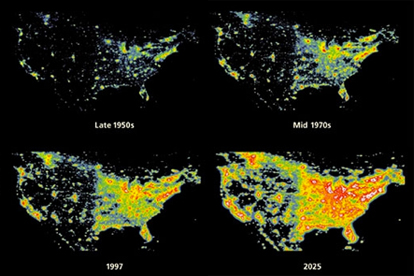
How Light Pollution Clouds the Night Sky
McDonald Observatory is profiled in a December feature on over-illuminated skies in Mens Journal. Image: Researchers from the University of Padua, in Italy and the National Geophysical Data Center in Boulder, Colorado, have collaborated on the first World Atlas of artificial night-sky brightness. Yellow represents 2x natural night-sky brightness. In orange zones, the Milky Way is no longer visible. Red zones mean fewer than 100 stars can be seen. Finally, in the white and pink zones, most prevalent in the projected 2025 map, the North Star and the Big Dipper have disappeared.
The 82" in 1939
December 2013
McDonald Observatory's Rachel Fuechsl describes observing with the Otto Struve Telescope at the time of its dedication.
An original scale model of the 82" is in storage in Ohio. Help bring it to West Texas for display through indiegogo.
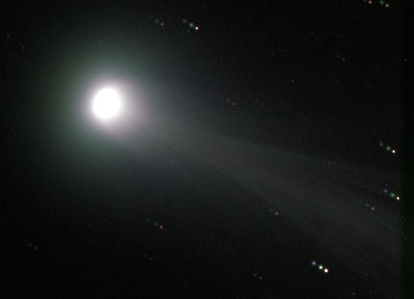
Comet ISON
An image of Comet ISON taken November 14, 2013 using the robotic 1-meter node of the Las Cumbres Observatory Global Telescope Network (LCOGT) located at McDonald Observatory. The comet will pass closer to the sun than the sun's diameter, on Thanksgiving Day, November 28. Will it survive? [image: T.Lister, E.Gomez]
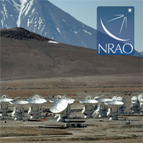
28 October 2013
An NRAO Community Day, sponsored by the National Radio Astronomy Observatory (NRAO) and the Department of Astronomy will be held on the Austin campus Friday, November 1 in the Peter O'Donnell Jr. Building. The sponsors are especially interested in reaching new users, without radio astronomy expertise. Photo: The ALMA array, located at 5,000 meters elevation in Chile, is the world's largest astronomical project.
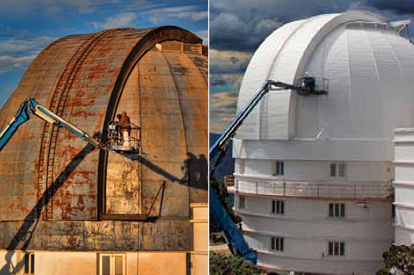
Dome Painting
The Otto Struve 2.1 m telescope was suspended from service September 6th through September 24th to support stripping and painting of the rotating part of the dome structure. The results are excellent.
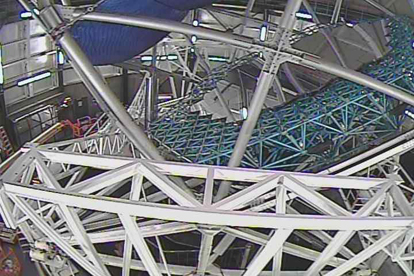
VIRUS Support Structure
The supporting framework for VIRUS, an array of 75 spectrograph pairs designed to capture 33,600 spectra at each exposure, has been installed onto the sides of the HET. Keep track of the HETDEX Wide Field Upgrade at HET Blog. Movies and live webcams can be found at HETDEX WFU. [photo: Coyne Gibson]
Third Mirror Casting Event for the Giant Magellan Telescope
GMTO Press Release
1 August 2013
On Saturday, August 24, 2013, the third mirror for the Giant Magellan Telescope (GMT) will be cast inside a rotating furnace at the University of Arizona's Steward Observatory Mirror Lab, the only facility in the world where mirrors of this size are being made. The Mirror Lab will host a rare media opportunity to witness this milestone in the creation of the optics for the GMT. Each of the seven mirrors weighs roughly 20 tons, yet the surface has to be smooth to within a twentieth of a wavelength of light. The GMT mirrors are considered to be the greatest astronomical optics challenge ever undertaken. Here's a short video discussing the mirror making process.
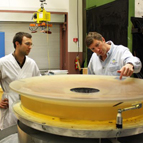
[Univ. of Arizona]
Successful Mirror Coatings Smooth Way for HET Upgrade
31 May 2013
The HETDEX project has passed an important milestone with the successful coating of the three largest mirrors in the wide-field corrector, a system that will focus light from the Hobby-Eberly Telescope's primary mirror and direct it to the scientific instruments. "The coating met all our specifications and it's very durable," says HETDEX principal investigator Gary Hill, the chief astronomer for McDonald Observatory. "There was risk associated with that because we had to transport the mirrors and handle them, and if one of them had broken, the project would have been derailed for several years." The University of Arizona Optical Sciences Center is building the corrector, which consists of four mirrors.
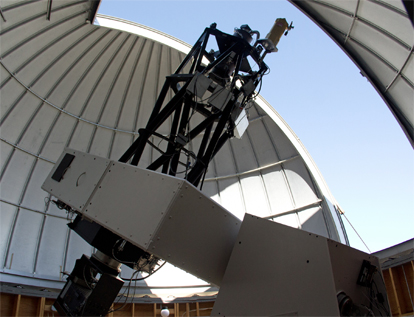
McDonald Observatory 0.8 m Telescope (30")
The 30 inch Telescope at McDonald was remounted in August of 2012, and can now be operated remotely. Readily available to graduate and undergraduate students, the telescope was used recently to analyze merging of nearby galaxies, search for extrasolar planets, and characterize potentially hazardous asteroids. [photo: Coyne Gibson]
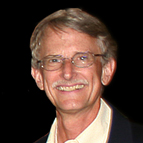
Prof. Neal J. Evans, II
18 April 2013
Edward Randall, Jr. M.D. Centennial Professor in Astronomy Neal J. Evans, II will be honored by students and colleagues from around the world, in a two day symposium, "Nealfest: Observing the Universe from Molecules to Galaxies," Thursday and Friday, April 25-26, at the Avaya Auditorium, ACES 2.302 [map] on the University of Texas at Austin campus. Presentations will reflect central themes of Dr. Evans' research: Protostellar Evolution and Star Formation, Interstellar Clouds and Molecular Chemistry, Star Formation Rates in the Milky Way and other Galaxies. Many former students, now representing some of the world's most prestigious astronomical institutions, will present research, including results from space observatories Spitzer and Herschel, and early results from the giant ALMA antenna array.
Undergraduate Astronomy Major Wins UT Student Employee of the Year, Astronomy Department Outstanding Senior Award
4 April 2013
Senior Kevin Luecke, who recently won University wide recognition as Student Employee of the Year, has been awarded the Astronomy Department's Outstanding Senior Award for 2013. Kevin's exceptional contribution has grown from participation in the University's innovative Freshman Research Initiative (FRI). The Astronomy Department sponsors two FRI streams, in Cosmology and White Dwarf research. Kevin has been instrumental in the development of the White Dwarf FRI stream, mentoring fellow students, and leading FRI groups on observing runs at McDonald Observatory. A dual major in Computer Science, Kevin has written CCD camera interface code, optimized analysis software for PC graphics cards, and uses 3D hydrodynamics code to run White Dwarf convection simulations on supercomputers at the Texas Advanced Computing Center (TACC). Kevin has worked under the supervision of Drs. Don Winget and Mike Montgomery.
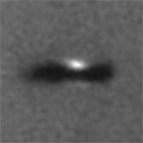
Protoplanetary Disk [STScI]
Science Seat: How to make a planet
By Nana Karikari-apau, CNN
8 March 2013
Sarah Dodson-Robinson is an assistant professor in the astronomy department at the University of Texas at Austin. She is a member of the American Astronomical Society and recently won the organization's Annie Jump Cannon Award for her work exploring how planets form. Dodson-Robinson says she enjoys discovering new things and coming up with new pieces of knowledge, no matter how small. She describes it as a "wonderful feeling." CNN Light Years recently chatted with Dodson-Robinson about her research. Here is an edited transcript:
CNN: What is the main goal of your research program?
Sarah Dodson-Robinson: My main goal is to answer the question, "How do planets form?" I’m interested in almost any type of planet, but my work so far is best known for its focus on supergiant planets, which are much more massive than Jupiter. I also study stars that host planets...
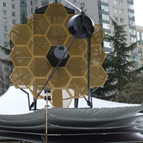
Webb Space Telescope Model
5 March 2013
University of Texas astronomers Karl Gebhardt, Sarah Tuttle and Steven Finkelstein will speak at a gala three-day South by Southwest Interactive "Space Exploration" event Friday, Saturday and Sunday, March 8-10, at Auditorium Shores, Austin. On outdoor exhibit, will be a full-scale model of the James Webb Space Telescope (JWST) the size of a tennis court and 4 stories high. The JWST is NASA's successor to the Hubble Space Telescope and will be 100 times more powerful. The three-day schedule includes a talk from Nobel Prize-winning astronomer John Mather and scientists from MIT and elsewhere; nightly star parties hosted by local astronomy clubs; and an attempt at breaking the Guinness Book record for the world's largest astronomy lesson. All events and exhibits are free and accessible without a festival pass. The event is sponsored by JWST builder Northrup Grumman.
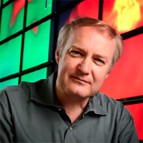
Dr. Volker Bromm
21st Annual Great Lecture in Astronomy: The First Stars and Galaxies
29 January 2013
Dr. Volker Bromm will deliver the 21st Annual Great Lecture in Astronomy, "The First Stars and Galaxies", February 9, 1-2 PM, at the Avaya Auditorium [map], ACES 2.302. The lecture is free and open to the public. The first generation of stars and galaxies were not the same as what is studied with current telescopes, but transformed the universe from a simple state to one of increasing complexity. Dr. Bromm models this cosmological era in large-scale simulations, on supercomputers at the Texas Advanced Computer Center. The James Webb and Giant Magellan Telescopes may soon offer the power to image this early time directly. The Great Lecture is sponsored by the Department of Astronomy and McDonald Observatory Board of Visitors.
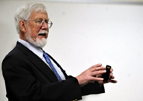
McDonald Observatory Director
David Lambert [Eric Shelton]
Black holes and dark matter: Abilene students learn about topics in astronomy
Abilene Reporter News
25 January 2013
Karl Gebhardt doesn't propose to make Texas the center of the universe, but rather the center of the study of the universe. Gebhardt and David Lambert, astronomers at the University of Texas at Austin, split chores Friday in talking to hundreds of Abilene high school and university students about November's announcement of the discovery of the largest black hole known to exist. The discovery was made with the Hobby-Eberly Telescope at the University of Texas McDonald Observatory in the Davis Mountains of far southwest Texas. Gebhardt and Lambert addressed students of Abilene's Academy of Technology, Engineering, Math & Science, Cooper High School, Abilene High School, HSU, McMurry University and Abilene Christian University.
How Light Pollution Clouds the Night Sky
Men's Journal
The largest optical telescope in North America belongs to McDonald Observatory, which sits atop a mountain in West Texas. Astronomers have come here to peer into black holes millions of light-years away, massive enough to contain 17 billion of our suns. more...

Bill Wren
Anson D'Aloisio Wins Yale University Brouwer Prize

Anson D'Aloisio
Postdoctoral Fellow Anson D'Aloisio has been awarded the 2013 Brouwer prize from the Yale University Department of Astronomy, for his 2011 Ph.D. dissertation "Cosmological Structures and Gravitational Lensing". The Dirk Brouwer Memorial Prize is awarded to students for contributions of unusual merit to astronomy. Dr. D'Aloisio works with Prof. Paul Shapiro, and is also a Research/Educator for the Freshman Research Initiative (FRI) stream "Cosmic Dawn".
First Year Graduate Students Receive Summer Research Fellowships

Aaron Smith

Jeremy Ritter
First year graduate students Aaron Smith and Jeremy Ritter have received summer research fellowships, funded in part by generous contributions from the following individuals:
Stephen Howard Blount, Sam and Sarah Cooper, Clint A. Davis, Bill and Sue Jefferys, Gery and Susan Muncey, and an Anonymous Donor.
Nearly all of the named donors are also members of the McDonald Observatory and Department of Astronomy Board of Visitors.
For more on the research of the graduates, see Graduate Program in the News.
Observatory director to retire
The Daily Texan
He first developed an interest in astronomy as a high school junior in Kent, England. He joined the UT Faculty in 1969. Now, after 10 years as director of UT's McDonald Observatory, David Lambert is planning to retire. "When I step down, I shall be 75, and that sounds old enough to let someone younger have a shot," Lambert said. "It will be nice to get fresh blood into the system." Lambert, who is also an astronomy professor, will step down by August 2014.
McDonald Observatory Officer Receives Prestigious Law Enforcement Award
Police officer Joe Mike Pasqua has been honored with the Texas Law Enforcement Achievement Award for Public Service, a state wide honor from the Texas Commission on Law Enforcement Officer Standards and Education.

Joe Mike was the August 2012 UT-system officer of the month.
